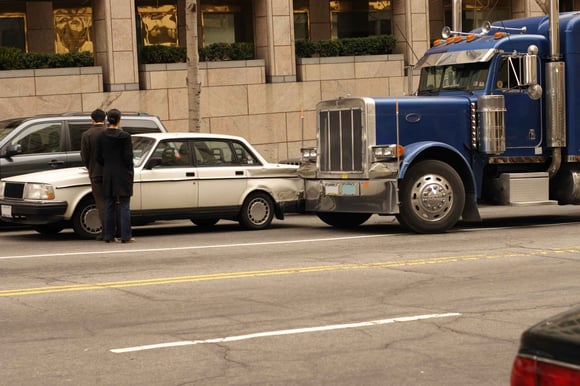How to Calculate Proper Following Distance Part 2

KNOW THE DEFENSE
At 65 mph, a fully-loaded tractor-trailer requires a minimum of 665 feet of stopping distance. The most reliable method drivers use to gauge this distance is by counting seconds. To do this, pick a stationary object on the side of the road, like a road sign or overpass, and, as soon as the vehicle in front passes your chosen object, begin counting: “one-one-thousand, two-one-thousand…”. Continue counting until your vehicle reaches that stationary object.
In general, establishing a minimum following distance of six seconds is necessary. The chart below demonstrates.

At 65 mph, keeping one second of following distance means the vehicle is traveling 100 feet behind the vehicle in front. It takes an automobile a minimum of 150 feet to stop. With a 100 foot gap plus the auto’s stopping distance of 150 feet, an impact would occur within 250 feet. Since it takes a truck 665 feet to stop, it is clear that one second of following distance will result in a rear-end crash. It is not until six seconds of following distance is established that a tractor-trailer has sufficient stopping distance. These are in ideal conditions. Add one additional second for each hazard present, such as rain.
The information in this article is provided as a courtesy of Great West Casualty Company and is part of the Value-Driven® Company program. Value-Driven Company was created to help educate and inform insureds so they can make better decisions, build a culture that values safety, and manage risk more effectively. To see what additional resources Great West Casualty Company can provide for its insureds, please click below to find an agent.
© Copyright Great West Casualty Company 2017. The material in this publication is the property of Great West Casualty Company unless otherwise noted and may not be reproduced without its written consent by any person other than a current insured of Great West Casualty Company for business purposes. Insured should attribute use as follows: “Used with permission by Great West Casualty Company.”
This material is intended to be a broad overview of the subject matter and is provided for informational purposes only. Great West Casualty Company does not provide legal advice to its insureds, nor does it advise insureds on employment-related issues. Therefore, the subject matter is not intended to serve as legal or employment advice for any issue(s) that may arise in the operations of its insureds. Legal advice should always be sought from the insured’s legal counsel. Great West Casualty Company shall have neither liability nor responsibility to any person or entity with respect to any loss, action, or inaction alleged to be caused directly or indirectly as a result of the information contained herein.




